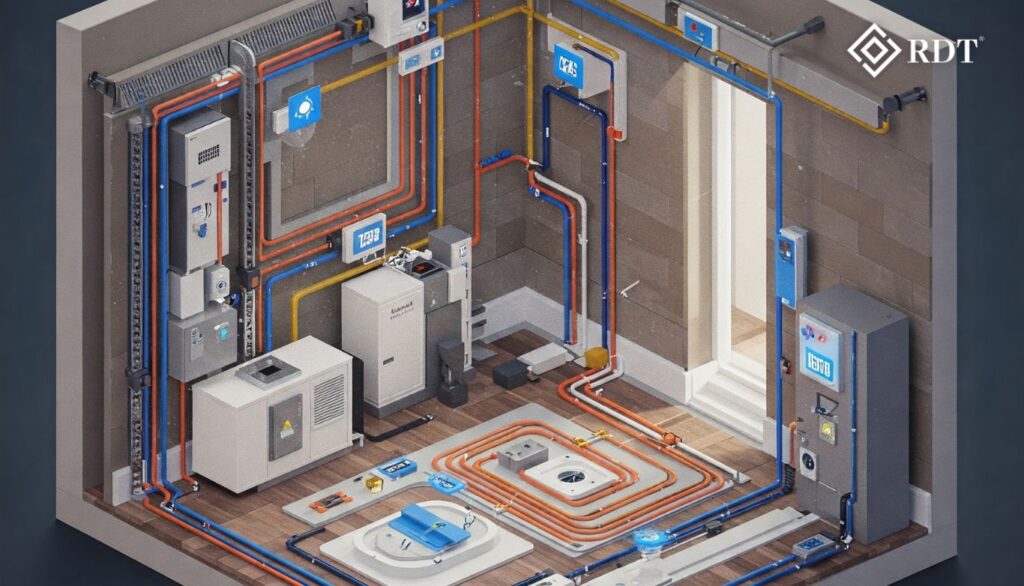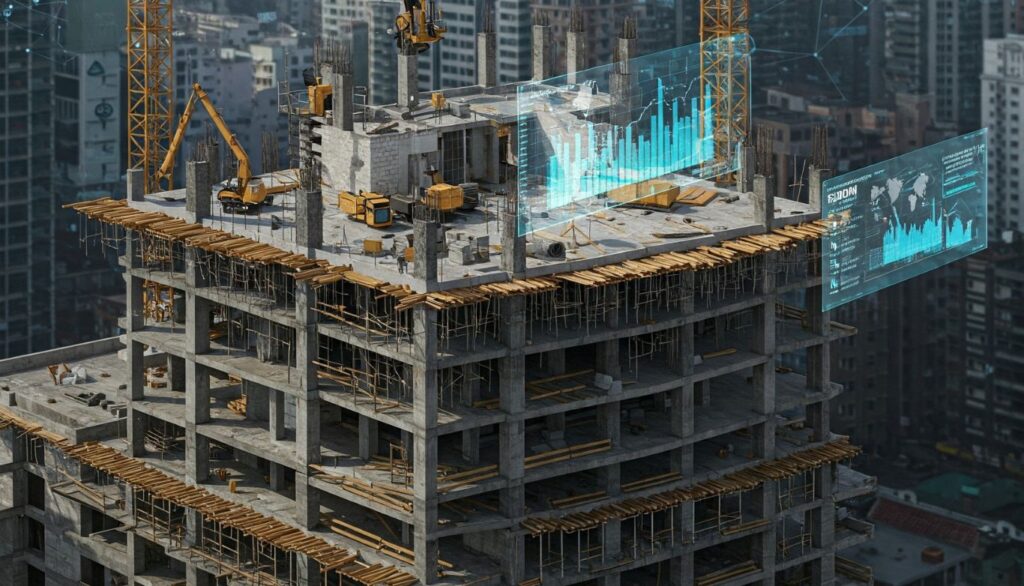This will be tailored for enterprise-level architects, AEC professionals, and developers specializing in high-end residential projects. It will cover the intricate application of BIM for prefabrication workflows, the integration of Digital Twins, advanced parametric design for mass customization, and the role of 5D and 6D simulations for cost and sustainability optimization. Expect detailed insights on modular construction logistics, AI-driven supply chain management, and MEP coordination using real-time data.
Let’s begin.
The Rise of Prefabrication in Luxury Homes – Faster, Cost-Effective, and Customizable
Prefabrication has traditionally been associated with mass-market, low-cost housing. However, in 2025, luxury residential architecture is experiencing a paradigm shift, with prefabrication emerging as a preferred methodology for elite, bespoke residences. Advanced BIM (Building Information Modeling) platforms, coupled with Digital Twin technology and AI-driven design systems, enable architects to achieve exceptional customization, cost control, and faster project delivery.
For enterprise-level architects and developers, understanding how to integrate prefabrication into the luxury home sector requires an intricate understanding of parametric design modeling, MEP (Mechanical, Electrical, Plumbing) coordination, and real-time data analytics. This blog explores the technical advancements driving prefabrication’s rise and how solutions can support seamless project execution.
1. Parametric Design and Mass Customization in Luxury Prefabrication

Generative Algorithms for Adaptive Design
In luxury housing, clients demand architectural uniqueness without compromising delivery timelines. Through parametric design algorithms using platforms like Grasshopper or Dynamo, architects can create bespoke prefabricated modules with infinite design permutations.
- Constraint-Driven Customization: Parametric software dynamically adjusts geometry, materials, and dimensions based on client preferences while ensuring structural stability.
- Real-Time Iteration: Computational models instantly update BIM models to reflect aesthetic adjustments, optimizing for both luxury appeal and manufacturability.
- Performance Validation: AI algorithms simulate structural loads, thermal behavior, and acoustics in real-time, identifying design anomalies before fabrication.
Advanced Panelization Techniques
- Algorithmic Panel Optimization: Machine learning algorithms determine optimal panel dimensions based on transport logistics, on-site crane access, and foundation load capacity.
- Multifunctional Panel Design: Integrated MEP routing ensures that conduits, ventilation ducts, and wiring systems are pre-installed within prefabricated walls and floor panels.
- Material Layering Simulations: Using 5D BIM, architects simulate the application of luxury materials like marble, glass composites, or bespoke timber, ensuring material compatibility during assembly.
2. BIM-Integrated Prefabrication for Production and Assembly
Manufacturing Digital Twins for Prefabrication
Digital Twins mirror real-time data from the factory floor, enabling architects, contractors, and developers to monitor the fabrication of luxury modules. Integrated with 6D BIM, this approach offers lifecycle tracking of every material and component.
- AI-Powered Predictive Analytics: Real-time sensor data ensures deviations in material quality or structural tolerances are immediately flagged.
- Automated Assembly Line Simulation: Machine learning algorithms predict the most efficient sequencing of robotic welding, cutting, and panel assembly processes.
- Just-in-Time Manufacturing: BIM-integrated ERP (Enterprise Resource Planning) systems synchronize prefabrication schedules with on-site assembly, preventing costly downtime.
Virtual Construction Sequencing (VCS)
Using 4D BIM, architects create detailed construction sequencing simulations that predict material handling, site logistics, and crane operations.
- Clash Detection: Real-time MEP coordination ensures that prefabricated elements are installed without conflicts.
- Modular Lifting Path Simulations: AI-based pathfinding algorithms optimize crane operations, reducing lifting time and preventing structural damage.
- On-Site Robotics Integration: Prefabricated modules are installed using autonomous robotics, which are guided by BIM-synchronized navigation systems.
3. Enhanced MEP Coordination Through AI and BIM

Multi-Trade Prefabrication (MTP)
Luxury homes often feature complex MEP systems that are integrated within prefabricated modules. AI-powered multi-trade prefabrication ensures seamless coordination across electrical, plumbing, and HVAC systems.
- 3D Spatial Coordination: Using Revit MEP or AutoCAD MEP, designers simulate precise routing for high-end systems like underfloor heating, water filtration, or automated climate control.
- AI-Enhanced Clash Detection: Machine learning algorithms analyze over 1,000 possible conflict scenarios, resolving issues before fabrication begins.
- Data-Driven Prefab Subassemblies: By embedding MEP sensors within prefabricated units, AI platforms predict operational performance and schedule predictive maintenance.
4. Cost Optimization Through 5D BIM and Digital Supply Chain Management

Real-Time Cost Simulation
Using 5D BIM, architects simulate construction costs based on various material selections, logistics routes, and labor availability.
- AI-Generated Cost Scenarios: Advanced algorithms perform Monte Carlo simulations to predict budget risks and generate optimized procurement strategies.
- Material Procurement Automation: Integration with ERP systems ensures accurate material orders and minimizes waste through real-time supply chain tracking.
- Dynamic Value Engineering: Luxury home architects perform automated value engineering analysis using AI, balancing material performance, aesthetic preferences, and budget constraints.
Logistics Optimization with AI
- Route Simulation: AI-powered algorithms analyze global supply chain data to identify the fastest and most cost-effective transport routes.
- Containerization Simulation: Prefabricated components are digitally arranged into optimized shipping containers using AI, reducing shipping costs by up to 20%.
- Real-Time Tracking: Through IoT-enabled sensors, architects monitor module location, temperature, and structural integrity throughout transit.
5. Sustainability in Prefabrication with 6D BIM
Lifecycle Carbon Footprint Reduction
Luxury home prefabrication reduces material waste and embodied carbon by consolidating production in a controlled factory setting. Through 6D BIM simulations, architects evaluate material choices for optimal sustainability.
- Material Lifecycle Analysis: AI algorithms predict the embodied carbon of various materials, suggesting lower-impact alternatives like carbon-neutral concrete or engineered timber.
- Waste Minimization: Generative design models reduce offcuts by optimizing panel shapes for efficient nesting during CNC machining.
- Energy-Efficient Manufacturing: Factories equipped with AI-powered sensors adjust production processes to reduce energy consumption and emissions.
Operational Sustainability Management
- Energy Simulation: Using IES VE or EnergyPlus, architects simulate a luxury home’s operational energy consumption and refine the HVAC and renewable energy systems.
- Smart Building Management: Integrated with BIM, smart home systems use AI to regulate energy consumption based on occupancy patterns and environmental conditions.
- Predictive Maintenance: Digital Twins monitor building systems, identifying maintenance needs before they escalate, extending equipment lifespan.
Conclusion
The future of luxury residential design is fundamentally intertwined with BIM-powered prefabrication. By leveraging parametric algorithms, AI-driven simulations, and Digital Twin integration, architects can achieve greater customization, faster construction timelines, and cost efficiency without compromising the exclusivity of luxury homes.
Enterprise-level architects are equipped to lead this prefabrication revolution. Expertise in high-end residential projects ensures precision, performance, and timeless design elegance.





